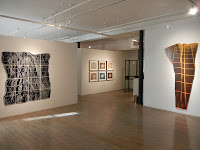Comments/Context: Long before the debates over the definition of truth in photography brought about by the digital revolution, Conceptual Art (and its cousin conceptual photography) explored the boundaries of what a photograph was and wasn't, what it could and could not represent, often with a mischievous sense of intellectual braininess. Mel Bochner has been a part of those discussions since the 1960s, and his newest works remind us that these thorny questions are far from completely answered.
The entry wall of the gallery contains a grid of six images, each a simple photograph of the same index card with the sentence "Photography Cannot Record Abstract Ideas" written on it, attributed to the Encyclopedia Britannica (shown in the middle of the top installation shot). If a photograph was an objective record of reality, perhaps the phrase on the card might have the ring of truth. But Bochner has taken this image and printed it six different times with six different antique processes, resulting in prints that range from silver and beige to light blue and chocolate brown. While the only variation is the chemical process being used, the final "reality" we are presented varies widely from image to image, not only in color and tonality, but it sharpness and contrast. Which one might be the true "truth"? Of course, the answer is that Bochner has done exactly what the card said he could not: record an abstract idea using photography. It has the feel of a witty mathematical proof, complete with a clever QED.
Most of the rest of the works in the show push and pull on the ideas of flatness and three-dimensionality, starting with a rigidly geometric white on black, and iterating and exploring from there. Preparatory drawings and quick Polaroids show Bochner refining the ideas in oil and shaving cream, and various of the final works have an optical illusion quality, where a clearly crumpled surface turns out to be completely flat, the lines of the grid becoming twisted and distorted. While the graphics are a bit dated, the concepts that support the pieces remain fresh and perplexing.
I think this exhibit is a good reminder that the conceptual questions that surround photography are not somehow all answered or "done"; original visual and thought experimentation combined with definitional explication are still valid paths forward that continue to yield unexpected, new results. As the medium evolves, old questions are brought forth once again to be answered in new (perhaps contradictory) ways. I'd like to believe this kind of show will encourage others to revisit and reengage with the thinking that underlies conceptual photography, generating a renaissance of ideas tuned for 21st century photographic discourse.
Collector's POV: Many of the works in this show are marked NFS. For those with stated prices, the Color Crumples are $225000 each, as is the Surface Dis/Tension (Recursion) work cut into 16 parts. A somewhat smaller gridded image is $75000 and the set of 6 photographic prints is $32000. The blue powder pigment on the wall is $350000. Bochner's works are surprisingly absent from the secondary markets for photography; while there may be an auction history for his works in other media, there is little or no recent record in the stand alone photography sales we track. As such, gallery retail may be the only viable option for photography collectors at this point, even though Bochner has been exploring the boundaries of photography for decades.
Rating: * (one star) GOOD (rating system described here)
Transit Hub:
- Artist site (here)
Through January 28th
Peter Freeman, Inc.
560 Broadway
New York, NY 10012




No comments:
Post a Comment